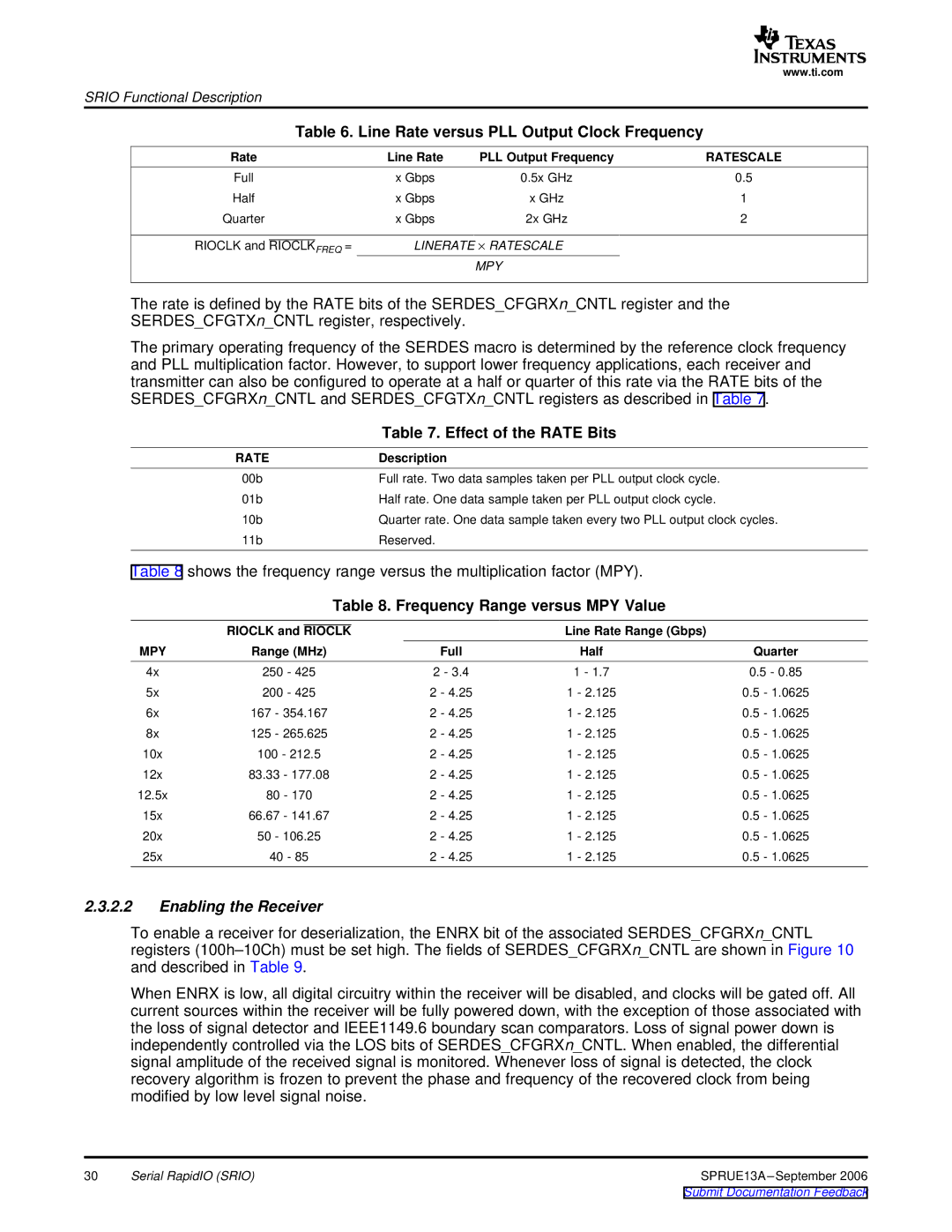
www.ti.com
SRIO Functional Description
Table 6. Line Rate versus PLL Output Clock Frequency
Rate | Line Rate | PLL Output Frequency | RATESCALE |
Full | x Gbps | 0.5x GHz | 0.5 |
Half | x Gbps | x GHz | 1 |
Quarter | x Gbps | 2x GHz | 2 |
RIOCLK and RIOCLKFREQ = | LINERATE × RATESCALE |
| |
|
| MPY |
|
The rate is defined by the RATE bits of the SERDES_CFGRXn_CNTL register and the SERDES_CFGTXn_CNTL register, respectively.
The primary operating frequency of the SERDES macro is determined by the reference clock frequency and PLL multiplication factor. However, to support lower frequency applications, each receiver and transmitter can also be configured to operate at a half or quarter of this rate via the RATE bits of the SERDES_CFGRXn_CNTL and SERDES_CFGTXn_CNTL registers as described in Table 7.
| Table 7. Effect of the RATE Bits |
RATE | Description |
00b | Full rate. Two data samples taken per PLL output clock cycle. |
01b | Half rate. One data sample taken per PLL output clock cycle. |
10b | Quarter rate. One data sample taken every two PLL output clock cycles. |
11b | Reserved. |
Table 8 shows the frequency range versus the multiplication factor (MPY).
Table 8. Frequency Range versus MPY Value
| RIOCLK and RIOCLK |
| Line Rate Range (Gbps) |
| ||
MPY | Range (MHz) | Full | Half | Quarter | ||
4x | 250 | - 425 | 2 - 3.4 | 1 - 1.7 | 0.5 - 0.85 | |
5x | 200 | - 425 | 2 - 4.25 | 1 - 2.125 | 0.5 - 1.0625 | |
6x | 167 | - 354.167 | 2 - 4.25 | 1 - 2.125 | 0.5 - 1.0625 | |
8x | 125 | - 265.625 | 2 - 4.25 | 1 - 2.125 | 0.5 - 1.0625 | |
10x | 100 - 212.5 | 2 - 4.25 | 1 - 2.125 | 0.5 - 1.0625 | ||
12x | 83.33 | - 177.08 | 2 - 4.25 | 1 - 2.125 | 0.5 - 1.0625 | |
12.5x | 80 | - 170 | 2 - 4.25 | 1 - 2.125 | 0.5 - 1.0625 | |
15x | 66.67 | - 141.67 | 2 - 4.25 | 1 - 2.125 | 0.5 - 1.0625 | |
20x | 50 | - 106.25 | 2 - 4.25 | 1 - 2.125 | 0.5 - 1.0625 | |
25x | 40 | - 85 | 2 - 4.25 | 1 - 2.125 | 0.5 - 1.0625 | |
2.3.2.2Enabling the Receiver
To enable a receiver for deserialization, the ENRX bit of the associated SERDES_CFGRXn_CNTL registers
When ENRX is low, all digital circuitry within the receiver will be disabled, and clocks will be gated off. All current sources within the receiver will be fully powered down, with the exception of those associated with the loss of signal detector and IEEE1149.6 boundary scan comparators. Loss of signal power down is independently controlled via the LOS bits of SERDES_CFGRXn_CNTL. When enabled, the differential signal amplitude of the received signal is monitored. Whenever loss of signal is detected, the clock recovery algorithm is frozen to prevent the phase and frequency of the recovered clock from being modified by low level signal noise.
30 | Serial RapidIO (SRIO) | SPRUE13A |
